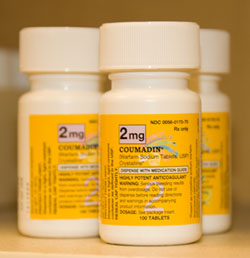
“Validation of Clinical Classification Schemes for Predicting Stroke”
JAMA. 2001 June 13;285(22):2864-70. [free full text]
—
Atrial fibrillation is the most common cardiac arrhythmia and affects 1-2% of the overall population with increasing prevalence as people age. Atrial fibrillation also carries substantial morbidity and mortality due to the risk of stroke and thromboembolism although the risk of embolic phenomenon varies widely across various subpopulations. In 2001, the only oral anticoagulation options available were warfarin and aspirin, which had relative risk reductions of 62% and 22%, respectively, consistent across these subpopulations. Clinicians felt that high risk patients should be anticoagulated, but the two common classification schemes, AFI and SPAF, were flawed. Patients were often classified as low risk in one scheme and high risk in the other. The schemes were derived retrospectively and were clinically ambiguous. Therefore, in 2001, a group of investigators combined the two existing schemes to create the CHADS2 scheme and applied it to a new data set.
Population (NRAF cohort): Hospitalized Medicare patients ages 65-95 with non-valvular AF not prescribed warfarin at hospital discharge.
Intervention: Determination of CHADS2 score (1 point for recent CHF, hypertension, age ≥ 75, and DM; 2 points for a history of stroke or TIA)
Comparison: AFI and SPAF risk schemes
Measured Outcome: Hospitalization rates for ischemic stroke (per ICD-9 codes from Medicare claims), stratified by CHADS2 / AFI / SPAF scores.
Calculated Outcome: performance of the various schemes, based on c statistic (a measure of predictive accuracy in a binary logistic regression model)
Results:
1733 patients were identified in the NRAF cohort. When compared to the AFI and SPAF trials, these patients tended be older (81 in NRAF vs. 69 in AFI vs. 69 in SPAF), have a higher burden of CHF (56% vs. 22% vs. 21%), are more likely to be female (58% vs. 34% vs. 28%), and have a history of DM (23% vs. 15% vs. 15%) or prior stroke/TIA (25% vs. 17% vs. 8%). The stroke rate was lowest in the group with a CHADS2 = 0 (1.9 per 100 patient years, adjusting for the assumption that aspirin was not taken). The stroke rate increased by a factor of approximately 1.5 for each 1-point increase in the CHADS2 score.
CHADS2 score NRAF Adjusted Stroke Rate per 100 Patient-Years
0 1.9
1 2.8
2 4.0
3 5.9
4 8.5
5 12.5
6 18.2
The CHADS2 scheme had a c statistic of 0.82 compared to 0.68 for the AFI scheme and 0.74 for the SPAF scheme.
Implication/Discussion
The CHADS2 scheme provides clinicians with a scoring system to help guide decision making for anticoagulation in patients with non-valvular AF.
The authors note that the application of the CHADS2 score could be useful in several clinical scenarios. First, it easily identifies patients at low risk of stroke (CHADS2 = 0) for whom anticoagulation with warfarin would probably not provide significant benefit. The authors argue that these patients should merely be offered aspirin. Second, the CHADS2 score could facilitate medication selection based on a patient-specific risk of stroke. Third, the CHADS2 score could help clinicians make decisions regarding anticoagulation in the perioperative setting by evaluating the risk of stroke against the hemorrhagic risk of the procedure. Although the CHADS2 is no longer the preferred risk-stratification scheme, the same concepts are still applicable to the more commonly used CHA2DS2-VASc.
This study had several strengths. First, the cohort was from seven states that represented all geographic regions of the United States. Second, CHADS2 was pre-specified based on previous studies and validated using the NRAF data set. Third, the NRAF data set was obtained from actual patient chart review as opposed to purely from an administrative database. Finally, the NRAF patients were older and sicker than those of the AFI and SPAF cohorts, and thus the CHADS2 appears to be generalizable to the very large demographic of frail, elderly Medicare patients.
As CHADS2 became widely used clinically in the early 2000s, its application to other cohorts generated a large intermediate-risk group (CHADS2 = 1), which was sometimes > 60% of the cohort (though in the NRAF cohort, CHADS2 = 1 accounted for 27% of the cohort). In clinical practice, this intermediate-risk group was to be offered either warfarin or aspirin. Clearly, a clinical-risk predictor that does not provide clear guidance in over 50% of patients needs to be improved. As a result, the CHA2DS2-VASc scoring system was developed from the Birmingham 2009 scheme. When compared head-to-head in registry data, CHA2DS2-VASc more effectively discriminated stroke risk among patients with a baseline CHADS2 score of 0 to 1. Because of this, CHA2DS2-VASc is the recommended risk stratification scheme in the AHA/ACC/HRS 2014 Practice Guideline for Atrial Fibrillation. In modern practice, anticoagulation is unnecessary when CHA2DS2-VASc score = 0, should be considered (vs. antiplatelet or no treatment) when score = 1, and is recommended when score ≥ 2.
Further Reading:
1. AHA/ACC/HRS 2014 Practice Guideline for Atrial Fibrillation
2. CHA2DS2-VASc (2010)
3. 2 Minute Medicine
Summary by Ryan Commins, MD
Image Credit: Alisa Machalek, NIGMS/NIH – National Insititue of General Medical Sciences, Public Domain
One thought on “Week 15 – CHADS2”